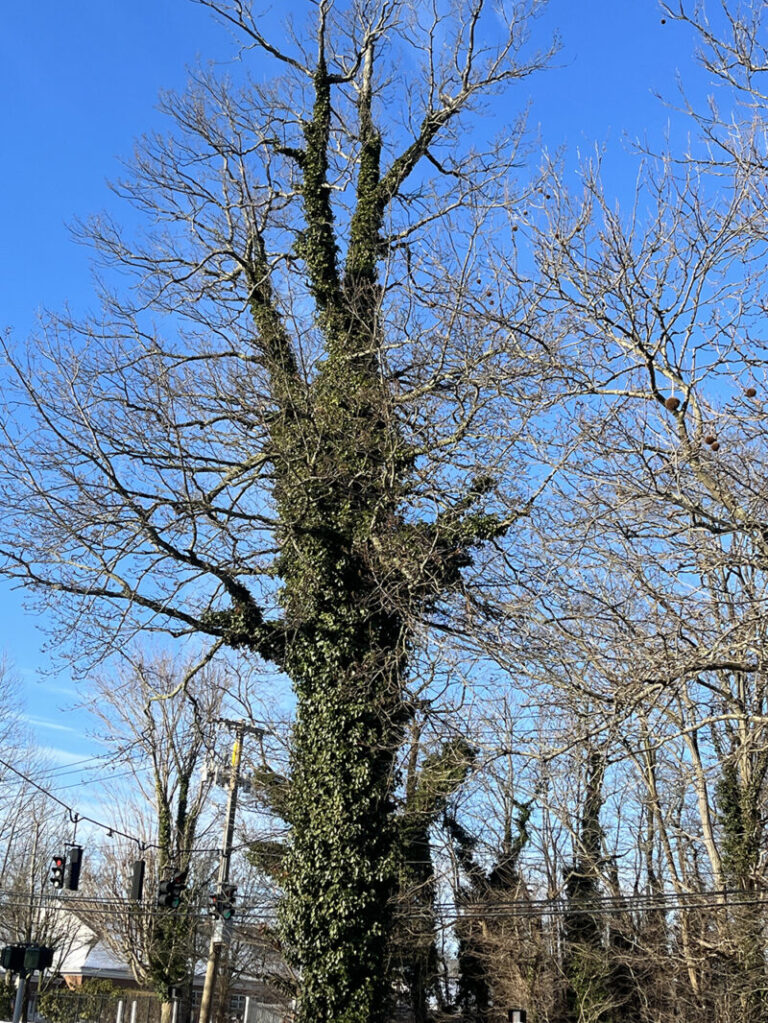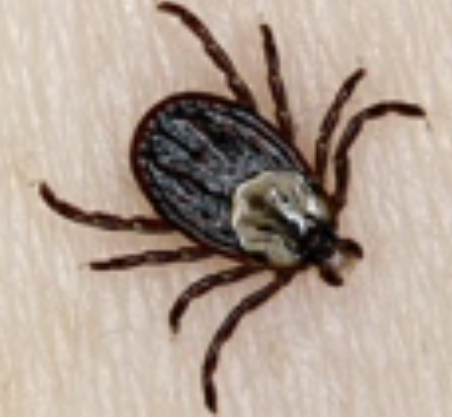The Three Village Community Trust’s Second Annual Awareness Campaign that’s Simply De-Vine
What’s green, spreads rapidly, is found everywhere, and is destructive to trees?
English Ivy. What’s not to love?
 You’ll see it climbing on trees in different areas throughout the Three Villages. And it blankets the ground of many areas with its dark green leaves and graceful tendrils. It also has a royal look- think large estates, or even the ivy covered walls of those prestigious colleges.
You’ll see it climbing on trees in different areas throughout the Three Villages. And it blankets the ground of many areas with its dark green leaves and graceful tendrils. It also has a royal look- think large estates, or even the ivy covered walls of those prestigious colleges.
Interestingly, the English Ivy (Hedera Helix) you commonly see was brought to North America by English settlers yearning for reminders of the old country.
Today, English Ivy grows throughout the northeast, and it has ‘rooted’ itself’ on Long Island in particular. It is found in landscaped beds, climbing on stone walls and chimneys, and climbing the trunks of trees. English Ivy is an inexpensive groundcover and is an effective way to stabilize soil on steep slopes and hills.
English Ivy – It is a Menace!
English ivy will gradually destroy everything you love – ok, maybe that’s a little dramatic – but it will make you pay a price for falling in love with its graceful looks.
You see, those tiny little roots or tendrils adhere to everything – slowly penetrating the surface of tree bark, mortar, wood trim, siding – anything that is not moving. For trees, English Ivy is deadly – the plant’s rootlets carry leaf scorch – a bacteria that is harmful to the tree, and it’s these tendrils that will open the bark to even more bacteria, and fungus. English Ivy can suffocate a tree by shielding it from needed sunlight. And, during storms, the ivy creates a ‘sail’ effect, allowing high winds to catch the trunk and branches of the tree and bring it down. If you let the ivy climb over parts of your home, you will eventually find yourself paying big bills for repairs to damaged chimneys, shingles, trim and siding.
Worse of all, allowing English Ivy to ‘climb’ will contribute to the rapid spread of this invasive species. Once ivy climbs high enough to be nourished by bright sunlight, it will produce small berries. Birds will eat these berries, and ivy seeds will be distributed far and wide through bird droppings. Yikes!
What to do if it is spreading on the ground …
While there are a number of solutions, the best is not to let it get started – don’t plant it and don’t transplant it. If you have it on your property continue to cut it back. Dispose of the pulled plants by bagging it up for your yard waste pickup. (Too many of people ‘dump’ their yard waste in public spaces, like the sides of roadways or parks, – allowing the spread of this creeping, crawly menace to take hold and spread …. and spread …. and spread …. )
What to do if the ivy is climbing on your trees.
You need a few things:
- Safety glasses
- Work gloves
- A small mallet or hammer
- Pruning shears and/or hack saw
- Small puller bar, crowbar, or nail puller
After donning your ‘safety gear,’ you need to clip the vines growing up the trees. Work at a comfortable height, though the closer you work to the base of the tree, the better. Keep in mind, anytime you work outside you could be exposed to ticks and poison ivy. Wear appropriate clothing and wash up with soap and water after your outdoor activities! It’s a good idea to wash all of your clothing, also.
Now, let’s get to work and do some damage to English Ivy!
- Identify the trees with ivy climbing on its trunks. Most trees in our area do not show ivy leaves in the first six or seven feet of growth – the deer have eaten it. But the vines are still there, and the leaves of the ivy can be seen as you look up.
- Gently pry a section of the vine off the tree and clip it with your shears, or if the vine is too thick, use the hack saw. (Hack saws are less likely to inadvertently hurt you in the cutting of the vines and do a good job cutting the bigger vines.) You do not want to harm the bark of the tree so use the pry bar to ‘lift’ each vine off the tree. Sometimes, you’ll need a mallet or hammer to tap the pry bar and get under the vine.
Work your way around the tree, until all the vines are clipped. After clipping each vine, if possible, grab the bottom part of the vine you just cut and pull it off the tree. Leave the upper portion. - Over time, the upper vines will wither and die, and will eventually fall from the tree. You will have to revisit your trees every couple of years to clip any new vines from climbing up your trees. Think of it as one of the routine yard maintenance jobs.
Your trees will love you for it!
Take part in the Three Village Community Trust’s effort to eliminate the spread of English Ivy in our area. This is our first English Ivy Awareness Campaign, and we are calling it “Simply De-Vine.”
Want a De-Vine lawn sign? Contact us at: tvcommtrust@optonline.net
Need more information about de-vining:
https://www.invasive.org/alien/pubs/midatlantic/hehe.htm
English Ivy: A Haven For Ticks?
From the: The Long Island Conservancy
 Trees are far too often overwhelmed by English Ivy — in yards, vacant lots, along our woods. A million trees, it seems, have been consigned to die because people are not really seeing what’s going on.
Trees are far too often overwhelmed by English Ivy — in yards, vacant lots, along our woods. A million trees, it seems, have been consigned to die because people are not really seeing what’s going on.
It was only three years ago that I came to understand just how destructive English Ivy is to our environment. Now, I can’t unsee it. It makes it tough just to drive up the street sometimes.
People will say “Well, it’s my property and I like it like this.” The problem here is that English Ivy spreads, and not just by their roots. Birds eat their berries, then fly off. That is why English Ivy is all over the trees at the edge of a woods or in vacant lots. This is where the birds will often fly next — not into the woods, but along them.
That English Ivy kills trees is one thing. Altering the very habitat of our forest edges is another. English Ivy is non-native; our local insects won’t eat it. No natural “enemies.” It just becomes the dominant ground cover for the forest floor near to the tree line, smothering everything out, and providing refuge creatures we don’t want anywhere near us.
It is in the grasses along the forest edge zones where the deer graze, where the ivy is prevalent, and where humans would enter the woods, and it is here where they each pick up ticks. Where from?: The White Footed Mouse has been determined to be the main vector for the spread of Lyme Disease.
What if there wasn’t English Ivy running rampant along our woodland edges, parks, yards, vacant lots? For one thing, we would see far fewer white-footed mice, as our local raptor population would spot them far more readily. Further, clearing the invasive ivy would also make the ticks themselves were far more visible to all that can eat them.
In conclusion then if we want to have an effective tick management policy, we will need to improve the prospects of their main predators, and we do that by systematically removing English Ivy from our property, public and private, lot by lot because its killing our trees anyway. Note this too: Robins also carry ticks. I even got one in my own yard, far away from any deer. Robins forage in those same edge grasses where the ticks also live. If we let our local lands go to ruin, it is no wonder we have more vermin than we should in our own yards. If you know a place in your community where English Ivy has grown rampant please let us know in the comments. We can help organize local resources for its removal. It’s a stunning realization to first learn how invasive English Ivy is and then how it impacts the health of our forests, the animals that live within them, and it seems our own. Up to 90% of white-footed mice carry Lyme Disease. Let’s not give them a place to hide.
Above is the abridged article. For the full article: https://longislandconservancy.org/2023/01/23/english-ivy-a-haven-for-ticks/




